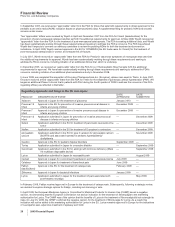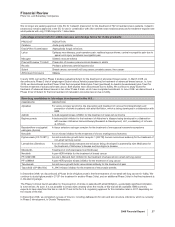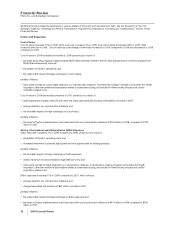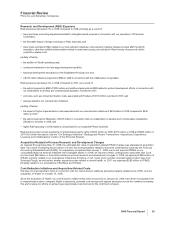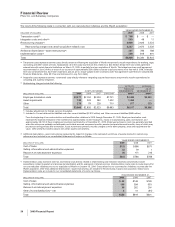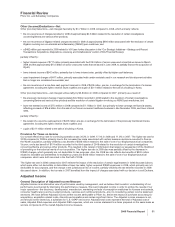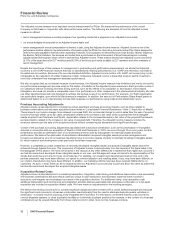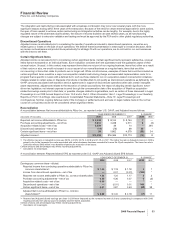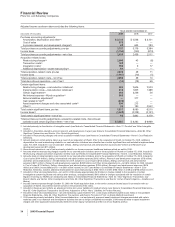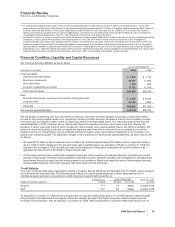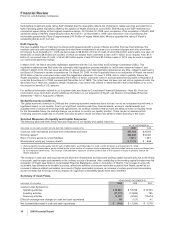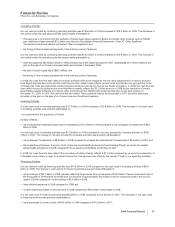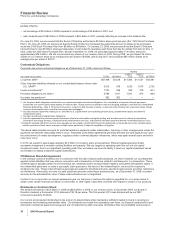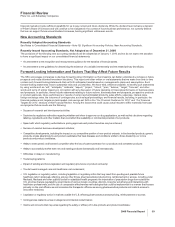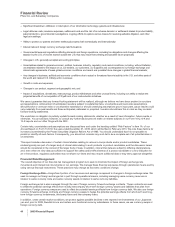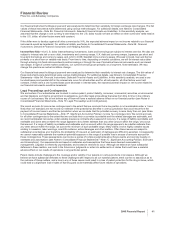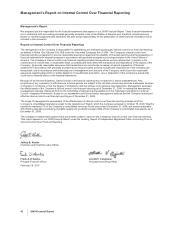Pfizer 2009 Annual Report Download - page 34
Download and view the complete annual report
Please find page 34 of the 2009 Pfizer annual report below. You can navigate through the pages in the report by either clicking on the pages listed below, or by using the keyword search tool below to find specific information within the annual report.
Financial Review
Pfizer Inc. and Subsidiary Companies
The Adjusted income measure is an important internal measurement for Pfizer. We measure the performance of the overall
Company on this basis in conjunction with other performance metrics. The following are examples of how the Adjusted income
measure is utilized:
•senior management receives a monthly analysis of our operating results that is prepared on an Adjusted income basis;
•our annual budgets are prepared on an Adjusted income basis; and
•senior management’s annual compensation is derived, in part, using this Adjusted income measure. Adjusted income is one of the
performance metrics utilized in the determination of bonuses under the Pfizer Inc. Executive Annual Incentive Plan that is designed to
limit the bonuses payable to the Executive Leadership Team (ELT) for purposes of Internal Revenue Code Section 162(m). Subject to
the Section 162(m) limitation, the bonuses are funded from a pool based on the achievement of three financial metrics, including
adjusted diluted earnings per share, which is derived from Adjusted income. These metrics derived from Adjusted income account for
(i) 17% of the target bonus for ELT members and (ii) 33% of the bonus pool made available to ELT members and other members of
senior management.
Despite the importance of this measure to management in goal setting and performance measurement, we stress that Adjusted
income is a non-GAAP financial measure that has no standardized meaning prescribed by U.S. GAAP and, therefore, has limits in
its usefulness to investors. Because of its non-standardized definition, Adjusted income (unlike U.S. GAAP net income) may not be
comparable to the calculation of similar measures of other companies. Adjusted income is presented solely to permit investors to
more fully understand how management assesses performance.
We also recognize that, as an internal measure of performance, the Adjusted income measure has limitations and we do not restrict
our performance-management process solely to this metric. A limitation of the Adjusted income measure is that it provides a view of
our operations without including all events during a period, such as the effects of an acquisition or amortization of purchased
intangibles, and does not provide a comparable view of our performance to other companies in the pharmaceutical industry. We also
use other specifically tailored tools designed to achieve the highest levels of our performance. For example, our R&D organization
has productivity targets, upon which its effectiveness is measured. In addition, the earn-out of Performance Share Award grants is
determined based on a non-discretionary formula that measures our performance using relative total shareholder return.
Purchase Accounting Adjustments
Adjusted income is calculated prior to considering certain significant purchase accounting impacts, such as those related to
business combinations and net asset acquisitions (see Notes to Consolidated Financial Statements––Note 2. Acquisition of Wyeth).
These impacts can include charges for purchased in-process R&D, the incremental charge to cost of sales from the sale of acquired
inventory that was written up to fair value, amortization related to the increase in fair value of the acquired finite-lived intangible
assets acquired from Pharmacia and Wyeth, depreciation related to the increase/decrease in fair value of the acquired fixed assets
and amortization related to the increase in fair value of acquired debt. Therefore, the Adjusted income measure includes the
revenues earned upon the sale of the acquired products without considering the aforementioned significant charges.
Certain of the purchase accounting adjustments associated with a business combination, such as the amortization of intangibles
acquired in connection with our acquisition of Wyeth in 2009 and Pharmacia in 2003, can occur through 20 or more years, but this
presentation provides an alternative view of our performance that is used by management to internally assess business
performance. We believe the elimination of amortization attributable to acquired intangible assets provides management and
investors an alternative view of our business results by trying to provide a degree of parity to internally developed intangible assets
for which research and development costs previously have been expensed.
However, a completely accurate comparison of internally developed intangible assets and acquired intangible assets cannot be
achieved through Adjusted income. This component of Adjusted income is derived solely from the impacts of the items listed in the
first paragraph of this section. We have not factored in the impacts of any other differences in experience that might have occurred if
we had discovered and developed those intangible assets on our own, and this approach does not intend to be representative of the
results that would have occurred in those circumstances. For example, our research and development costs in total, and in the
periods presented, may have been different; our speed to commercialization and resulting sales, if any, may have been different; or
our costs to manufacture may have been different. In addition, our marketing efforts may have been received differently by our
customers. As such, in total, there can be no assurance that our Adjusted income amounts would have been the same as presented
had we discovered and developed the acquired intangible assets.
Acquisition-Related Costs
Adjusted income is calculated prior to considering transaction, integration, restructuring and additional depreciation costs associated
with business combinations because these costs are unique to each transaction and represent costs that were incurred to
restructure and integrate two businesses as a result of the acquisition decision. For additional clarity, only transaction costs,
additional depreciation and restructuring and integration activities that are associated with a business combination or a net-asset
acquisition are included in acquisition-related costs. We have made no adjustments for the resulting synergies.
We believe that viewing income prior to considering these charges provides investors with a useful additional perspective because
the significant costs incurred in a business combination result primarily from the need to eliminate duplicate assets, activities or
employees––a natural result of acquiring a fully integrated set of activities. For this reason, we believe that the costs incurred to
convert disparate systems, to close duplicative facilities or to eliminate duplicate positions (for example, in the context of a business
combination) can be viewed differently from those costs incurred in other, more normal, business contexts.
32 2009 Financial Report






